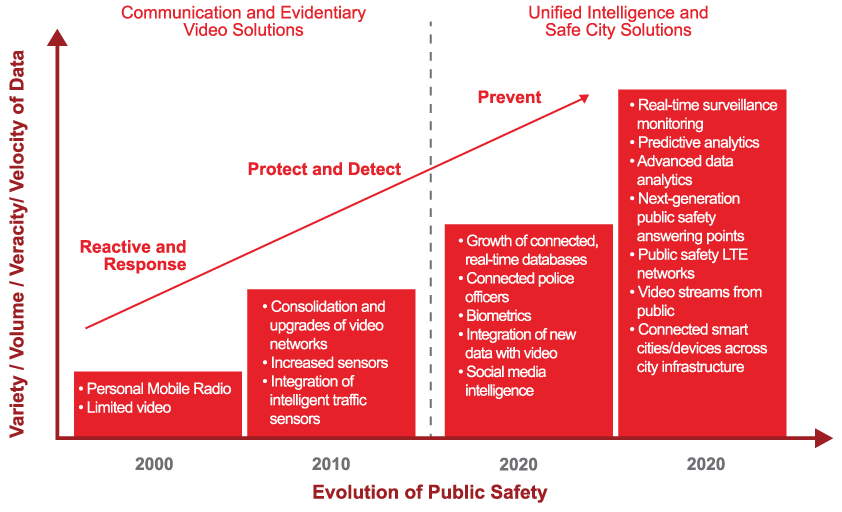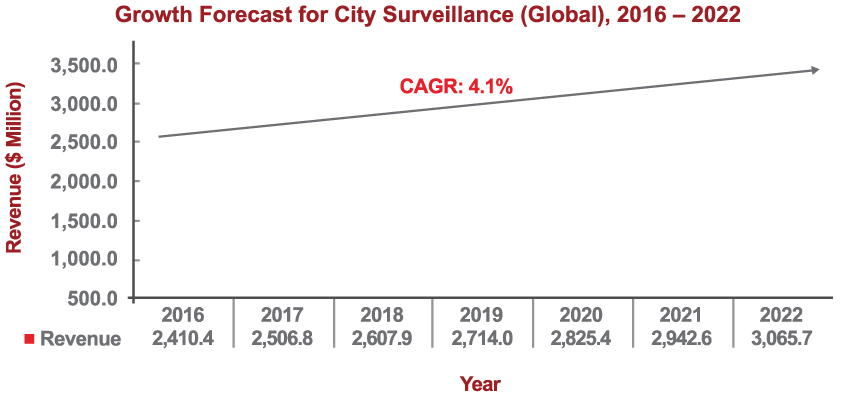


There are two distinct phases in the evolution of public safety. Historically, the focus of technology investment has been on communication and evidentiary solutions. Video surveillance has largely been one of the critical technologies for public safety. The number of installed cameras across cities and critical infrastructure is vast and continues to grow. Upgrades and development of camera networks will continue.
But the future focus is to improve the use of video surveillance and analytics for public safety and transition from an evidence system to a real-time situational awareness tool focused on incident prevention. At present, monitoring a citywide camera network is an unachievable task, but IoT solutions for better analytics and development of machine learning will provide the answers to make this a much more effective tool.
The convergence of IoT with surveillance solutions is driving strong growth in the overall city surveillance market (made up of cameras, video management systems, analytics and data storage), with over $2.5 billion spent globally in 2017 alone. This will surpass $3 billion per year by 2022.
City Surveillance Forecast
“Surveillance will move beyond a prevention and evidentiary tool to be used for real-time monitoring to provide better situational awareness across cities and major events”
1. Advanced Video Analytics
2. Remote Monitoring
3. Increased Situational Awareness
4. Improved Operational Efficiencies


Advanced video analytics will be one of the most dynamic growth applications arising from this trend. Critical functionalities will include facial recognition, license plate recognition, scene analysis, left objects, and crowd detection. The reliability of these has improved considerably over the past five years and will continue to get better. In the future, these will provide powerful tools to help monitor events in real time. However, video surveillance is only one element of security solutions.

By 2025, public safety agencies will transition away from reactive technologies towards a unified intelligence centre. All data will be collected from a range of sources across a city and sent to an advanced command and control system. Information is collated, analysed and presented to operational command so that they have a single, common and real-time operational view of a situation. This can then flow back and forth to resources and operational personnel on the ground, allowing them to better coordinate, dispatch, and monitor resources and response.
Impact of Technology 2005-2025
By 2025, the goal is to break down data silos and barriers that have prevented information sharing to allow public safety agencies to have access to the right information to inform real-time and intelligent decision making. The rise of new technologies outlined above will facilitate this by helping to generate actionable insights of all the information, running advanced analytics, correlating trends, and identifying issues.
Impact of Technology 2005-2025

Presenting data in a clear and coherent way to operators and disregarding irrelevant information is critical. A common issue is not having the right information at the right time. This has been a criticism of some of the largest security incidents that could have been prevented by security agencies over the past decade. In many cases, the major criticism was that data wasn’t shared or connected to create the full story.

Data & Analytics in Public Safety
“The extraction, analysis, management and use of data will be the cornerstone of security moving forward.”
Data is KING
Use of Data
Actionable intelligence – Ensuring that only relevant data is shown to facilitate decision making
Visualisation
Clarity to the end user – What does the data mean and what should be done?
Ease of Integration
Different sources of data stored and anaylsed in multiple operating systems/ databases
Access/ Sharing
Increased multi–agency collaboration: Ensuring the right people at the right time
Storage of Data
Changing storage models:
• Public Cloud
• Private Cloud
• On-premise Hybrid